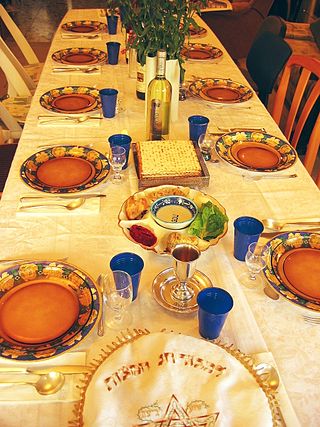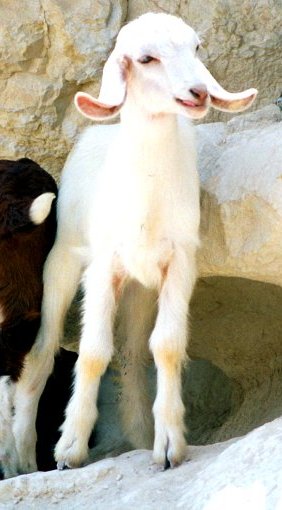
Passover, also called Pesach, is a major Jewish holiday for Rabbinical Judaism, Karaite Judaism, and Samaritanism, one of the Three Pilgrimage Festivals, that celebrates the Exodus of the Israelites from slavery in Biblical Egypt.

The Passover Seder is a ritual feast at the beginning of the Jewish holiday of Passover. It is conducted throughout the world on the eve of the 15th day of Nisan in the Hebrew calendar. The day falls in late March or in April of the Gregorian calendar; Passover lasts for seven days in Israel and eight days outside Israel. Jews traditionally observe one seder if in Israel and two if in the Jewish diaspora. The Seder is a ritual involving a retelling of the story of the liberation of the Israelites from slavery in ancient Egypt, taken from the Book of Exodus in the Torah. The Seder itself is based on the Biblical verse commanding Jews to retell the story of the Exodus from Egypt: "You shall tell your child on that day, saying, 'It is because of what the LORD did for me when I came out of Egypt.'" At the seder, Jews read the text of the Haggadah, an ancient Tannaitic work. The Haggadah contains the narrative of the Israelite exodus from Egypt, special blessings and rituals, Talmudic commentaries, and Passover songs.

Kitniyot is a Hebrew word meaning legumes. During the Passover holiday, however, the word kitniyot takes on a broader meaning to include grains and seeds such as rice, corn, sunflower seeds, and sesame seeds, in addition to legumes such as beans, peas, and lentils.

The Haggadah is a Jewish text that sets forth the order of the Passover Seder. According to Jewish practice, reading the Haggadah at the Seder table is a fulfillment of the mitzvah to each Jew to tell their children the story from the Book of Exodus about God bringing the Israelites out of slavery in Egypt, with a strong hand and an outstretched arm.

Maxwell House is an American brand of coffee manufactured by a like-named division of Kraft Heinz in North America and JDE Peet's in the rest of the world. Introduced in 1892 by wholesale grocer Joel Owsley Cheek, it was named in honor of the Maxwell House Hotel in Nashville, Tennessee, which was its first major customer. For nearly 100 years, until the late 1980s, it was the highest-selling coffee brand in the United States. The company's slogan is "Good to the last drop," which is often incorporated into its logo and is printed on its labels.

The Sarajevo Haggadah is an illuminated manuscript that contains the illustrated traditional text of the Passover Haggadah which accompanies the Passover Seder. It belongs to a group of Spanish-Provençal Sephardic Haggadahs, originating "somewhere in northern Spain", most likely city of Barcelona, around 1350, and is one of the oldest of its kind in the world.

Dayenu is a song that is part of the Jewish holiday of Passover. The word "dayenu" means approximately "it would have been enough", "it would have been sufficient", or "it would have sufficed". This traditional up-beat Passover song is over one thousand years old. The earliest full text of the song occurs in the first medieval haggadah, which is part of the ninth-century Seder Rav Amram. The song is about being grateful to God for all of the gifts given to the Jewish people, such as taking them out of slavery, giving them the Torah and Shabbat, and had God only given one of the gifts, it would have still been enough. This is to show much greater appreciation for all of them as a whole. The song appears in the haggadah after the telling of the story of the exodus and just before the explanation of Passover, matzah, and the maror.

The Passover Seder plate is a special plate containing symbolic foods eaten or displayed at the Passover Seder. It is used to show all the symbolic foods that are used for the Passover Seder.

Pesachim, also spelled Pesahim, is the third tractate of Seder Moed of the Mishnah and of the Talmud. The tractate discusses the topics related to the Jewish holiday of Passover, and the Passover sacrifice, both called "Pesach" in Hebrew. The tractate deals with the laws of matza and maror, the prohibitions against owning or consuming chametz (leaven) on the festival, the details of the Paschal lamb that used to be offered at the Temple in Jerusalem, the order of the feast on the first evening of the holiday known as the Passover seder, and the laws of the supplemental "Second Pesach".

Afikoman based on Greek epikomon [ἐπὶ κῶμον] or epikomion [ἐπικώμιον], meaning "that which comes after" or "dessert"), a word originally having the connotation of "refreshments eaten after the meal", is now almost strictly associated with the half-piece of matzo which is broken in two during the early stages of the Passover Seder and set aside to be eaten as a dessert after the meal.

Chad GadyaorHad Gadya is a playful cumulative song in Aramaic and Hebrew. It is sung at the end of the Passover Seder, the Jewish ritual feast that marks the beginning of the Jewish holiday of Passover. The melody may have its roots in Medieval German folk music. It first appeared in a Haggadah printed in Prague in 1590, which makes it the most recent inclusion in the traditional Passover seder liturgy.
The Haggada of the Jewish Idea, or Haggadah of the Jewish Idea is a book written by Binyamin Ze'ev Kahane based on his commentary of the classic Passover Haggada, which is based on his father, Rabbi Meir Kahane's teachings of the "Jewish Idea". The book's commentary focuses on the "Jewish Idea" in general, particularly the concept of faith in God. It also focuses on the approach to Passover, and the nighttime Seder which would, "define the faith of the Jew."

The White House Passover Seder was an annual private dinner held at the White House on the Jewish holiday of Passover during the presidency of Barack Obama. Obama initiated it in 2009 for his family, staff members, friends, and their families. The gathering recited the Passover Haggadah, discussed the themes of the Passover Seder and their relation to current events, and partook of a holiday-themed meal. Obama hosted and attended the Seder each year from 2009 to 2016. It was the first Passover Seder to be conducted by a sitting U.S. president in the White House.

Ha Lachma Anya is a declaration that is recited at the beginning of the Magid portion of the Passover Seder. Written in Aramaic, the recitation serves as the first explanation of the purpose of the matzo during the Seder.
L'Shana Haba'ah B'Yerushalayim, lit. "to a year to come in Jerusalem" but most often rendered "Next year in Jerusalem", is a phrase that is often sung at the end of the Passover Seder and at the end of the Ne'ila service on Yom Kippur. Its use during Passover was first recorded by Isaac Tyrnau in his 15th century CE book cataloging the Minhaggim of various Ashkenazi communities.
Carole Beth Balin is a Reform rabbi and professor of Jewish history at Hebrew Union College-Jewish Institute of Religion in New York City. Her research interests include Eastern European and American Jewish history, the history of Reform Judaism, and gender studies. She received laudatory reviews for her 2003 book To Reveal Our Hearts: Jewish Women Writers in Tsarist Russia, and has co-edited two other books. She is a co-curator of "Bat Mitzvah Comes of Age", a traveling exhibition sponsored by the Smithsonian-affiliated National Museum of American Jewish History and the Moving Traditions Jewish non-profit.

The Birds' Head Haggadah is the oldest surviving illuminated Ashkenazi Passover Haggadah. The manuscript, produced in the Upper Rhine region of Southern Germany in the early 14th century, contains the full Hebrew text of the Haggadah, a ritual text recounting the story of Passover – the liberation of the Israelites from slavery in ancient Egypt – which is recited by participants at a Passover Seder. The text is executed in block calligraphy and accompanied by colorful illustrations of Jews performing the Seder practices and reenacting Jewish historical events. The Birds' Head Haggadah is so called because all Jewish men, women, and children depicted in the manuscript have human bodies with the faces and beaks of birds. Non-Jewish and non-human faces are blank or blurred. Numerous theories have been advanced to explain the unusual iconography, usually tied to Jewish aniconism. The Haggadah is in the possession of the Israel Museum in Jerusalem, where it is on permanent exhibition.
Le'Or is a 501(c)(3) organization in Portland, Oregon. It was founded in 2015 by Roy and Claire Kaufmann. The group publishes a haggadah via its website that substitutes cannabis for lettuce in the seder plate and promotes consumption of cannabis as part of the sacred rituals of Pesach (Passover). The haggadah includes the "Ten Plagues of the Drug War" and was meant to inspire discussion about the meaning of bondage in the modern age of mass incarceration and the war on drugs.
Vehi Sheamda is a Jewish piyyut in the Haggadah of Passover Seder that mention's God's promise of ending the exile of the Jews from the Land of Israel.

The Golden Haggadah is an illuminated Hebrew manuscript originating around c. 1320–1330 in Catalonia. It is an example of an Illustrated Haggadah, a religious text for Jewish Passover. It contains many lavish illustrations in the High Gothic style with Italianate influence, and is perhaps one of the most distinguished illustrated manuscripts created in Spain. The Golden Haggadah is now in the British Library and can be fully viewed as part of their Digitized Manuscript Collection MS 27210.


















